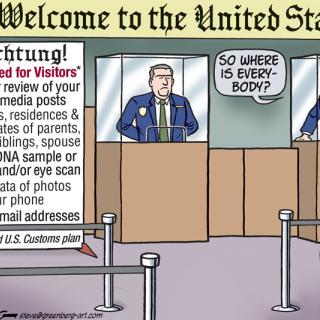Early Franklinton and Columbus’ forgotten beginnings
Dismissed, when even noticed by City government and city residents alike, Columbus’ historical, political, economic, social, and cultural origins lay in Franklinton. The district is now on the southeastern edge of downtown but it was long the center. Historians, geographers, archaeologists, and genealogists can read the signs on the ground and in the libraries. But they are unknown to most residents including the governing class and their inseparable developers. Among many reasons are Columbus’ lack of any traditions of professional self-study, the failings of its educational and cultural institutions, and the disinterestedness of its journalists. (See my essays on the City of Columbus and the University District in Columbus Free Press; contrast them, for example, with Ed Lentz’s Columbus Dispatch’s antiquarian vignettes always taken out of historical context and without consideration of significance. Franklinton is not in the index of only serious scholarly book on Columbus, Kevin Cox, Boomtown Columbus. Ohio State University Press, 2021)
Settled in 1797, Franklinton was the first European American settlement in Franklin County, and the county seat until 1824. As Columbus grew, as with so much of the adjacent area, the city annexed Franklinton in 1859. Annexation, a political action by the dominant authority, has long been the city’s primary engine for growth. (See Cox, Boomtown Columbus) Throughout its history, the Scioto River on its north and east bordered the neighborhood, for better and for worse.
Part of the area has long been called The Bottoms, sometimes descriptively, sometimes pejoratively, because of the likelihood of flooding from either or both the Scioto and Olentangy Rivers. At the same time, the low-lying land was also well-suited to farming as the rivers provided a direct connection to the Ohio River.
Two centuries of contradictions
Such contradictions are central to Franklinton’s present as well as past. It is a story of flooding and slowly improving flood walls, paralleled by rising and falling property values, and neighborhood transitions typical of U.S. cities. These changes over time are often exaggerated by the Columbus context. For example, completion of the newest floodwall in 2004 combined demolition of three much-needed public housing projects, thus displacing residents. There was no responsible planning or coordinated action. Predominantly luxury, aesthetically inappropriate mixed-use building accelerated very uneven gentrification of the area. That is urban redevelopment the Columbus Way.
Early Franklinton
Lucas Sullivant, a surveyor for the Commonwealth of Virginia, led a crew to the confluence of the two rivers in 1795. In compensation for his work, he received 6,000 acres. In 1797, he returned to the area, and laid out village of 220 lots which he named in Benjamin Franklin’s memory.
Reflecting the topography and the future, the next year a flood submerged most of the new town. Sullivant rebuilt on higher ground. Foreshadowing the Columbus Way, to attract new settlers he offered free land to anyone building near the eastern edge. He also built a courthouse, brick church, brick home to impress Sarah Starling who he married in 1801, and the first bridge across the Scioto River.
The new town became the county seat in 1803 when Franklin County separated from Ross County. Its population grew during the War of 1812 when it served as a staging point for William Henry Harrison’s Army of the Northwest. Growth continued with the expansion of the railroad and construction of new state capital in Columbus across the Scioto River. In 1824, Columbus became county seat, and annexed Franklinton in 1859. Before the Civil War, the area was a destination for slaves on the Underground Railroad.
During the second half of the nineteenth century, Franklinton was among the city’s economic engines. Four railroad carriers stimulated commerce and industry. By century’s end, demand led to interurban railways as well as throughways. In the process, Franklinton became an urban place known for railroad cars and horse-drawn buggies, attracting migrants from southwestern Ohio, Kentucky, and West Virginia. Many settled in East Franklinton because of locations of work. The area continued to suffer frequent flooding.
In 1889, Columbus spent $50,000 to construct levees along the banks of the Scioto. Most of present-day Franklinton was built after their completion. On September 14, 1897, Columbus celebrated Franklinton’s centennial. Local and notable guests praised Sullivant. Yet many also noted that the flood-prone location was unfit for platting and settlers, and that the original design failed to include alleys.
Twentieth century transitions and continuities
As residents, industry, and commerce grew into the new century, Franklinton suffered extreme flooding, most dramatically the Great Flood of 1913. Rain forced the levees’ collapse; waters rising from 7 to 17 feet engulfed the area. Rising waters killed at least 93 people, and left 23,000 homeless. Almost 500 buildings and all bridges in downtown were lost. Many residents relocated to nearby Hilltop neighborhood. Property values fell as much as 50 per cent. Total losses were estimated at $22 million. The flood led, at last, to Columbus’ first watershed and flood-control planning.
Contradictions continue to mark the area. During World War II, B&T Metals in East Franklinton produced uranium reactor fuel for the Hanford nuclear reactor, part of the Manhattan Project. Employment grew but workers received no protection from radiation.
The site was not remediated until 2001. The building not demolished until 2011, with the northwest corner of the building at 435 W. Town Street, the site of most of the contaminated material, still standing destructively to the human and natural environment. The last major flood occurred in 1959 with the Scioto cresting at 27 feet above flood stage.
In 1983, the Federal Emergency Management Agency finally ruled that almost all of Franklinton lay in a flood plain at risk of annual flooding. City Council passed an ordinance restricting new construction. All new construction must meet minimum criteria of the National Flood Insurance Program. Consequently, Franklinton lost population.
In the same decades, construction of the Interstate Highway System also had a major impact. Sandusky Street buildings were removed; property values fell and families left East Franklinton for the Hilltop or the suburbs. The City did not respond with housing assistance or other responsible policies whether funded locally or federally. Inner-belt construction almost formed a barrier that sealed off part of East Franklinton from the rest of the area. This in turn was reinforced with the construction of West Interstate 70.
Another transition began with the operation of the first gay night club, Rudely Elegant, on West Broad Street in the art-deco Avondale Theater from 1977-1985. Open to gays and heterosexuals, this club, and its Franklinton by downtown location, was notable for its openness and themed costume parties. Now the site of a pawn shop, the club was featured in a Columbus Museum of Arts exhibit in 2019-2020. It is not an active part of the city’s historical memory.
Inexplicably, Franklinton was subdivided into three sub-districts: Broad Street, Arts and Innovation, and Dodge Park. For one historic urban neighborhood, this makes no sense, but it follows an East Franklinton Plan. Broad Street and Arts and Innovation “strongly support mixed use,” whereas Dodge Park has a residential emphasis. This reflects the history of non-planning in Columbus.
Nonetheless, both single and multi-family residential plots spread throughout the area. This includes neighborhood and regional commercial land uses, large office complexes, and a retail center. Many manufacturing land uses persist with a concentration along McKinley and Harmon Avenues. The Center of Science and Industry (COSI) and National Veterans Memorial and Museum sit on the border with downtown adjacent to Genoa Park. Parking lots and un- or under-developed areas surround them. They are not integrated into the neighborhood.
This is not responsible urban planning. It is a set of institutional contradictions and a recipe for uneven, unmanaged, and unequal patterns of some gain with much loss.
Harvey J. Graff on Columbus
“Columbus’ identity crisis and its media”
“Columbus city government is undemocratic and disorganized: It’s 2021 and we need a revolution”
“Columbus searches for its Downtown with historical, urbanist, and developers’ blinders”
“Columbus, Ohio, searches to be a city: The myth of the Columbus Way”
“Columbus isn’t Cowtown or Silicon Valley Heartland; it’s the lawless, wild-wild-Midwest”
https://columbusfreepress.com/article/my-short-life-%E2%80%9Ccivic-leade...
“In the Columbus Way, Columbus residents have no rights,” in press
---------------------------------------------------
Harvey J. Graff is Professor Emeritus of English and History at The Ohio State University and inaugural Ohio Eminent Scholar in Literacy Studies. Author of many books on social history, the history of literacy and education, and interdisciplinarity, he writes about the history and contemporary condition of higher education for Times Higher Education, Inside Higher Education, Academe Blog, Washington Monthly, Publishers Weekly, Against the Current; Columbus Free Press; and newspapers. Searching for Literacy: The Social and Intellectual Origins of Literacy Studies is published by Palgrave Macmillan this summer. He thanks Franklinton’s Rebecca Hundley for her information and commentary.



